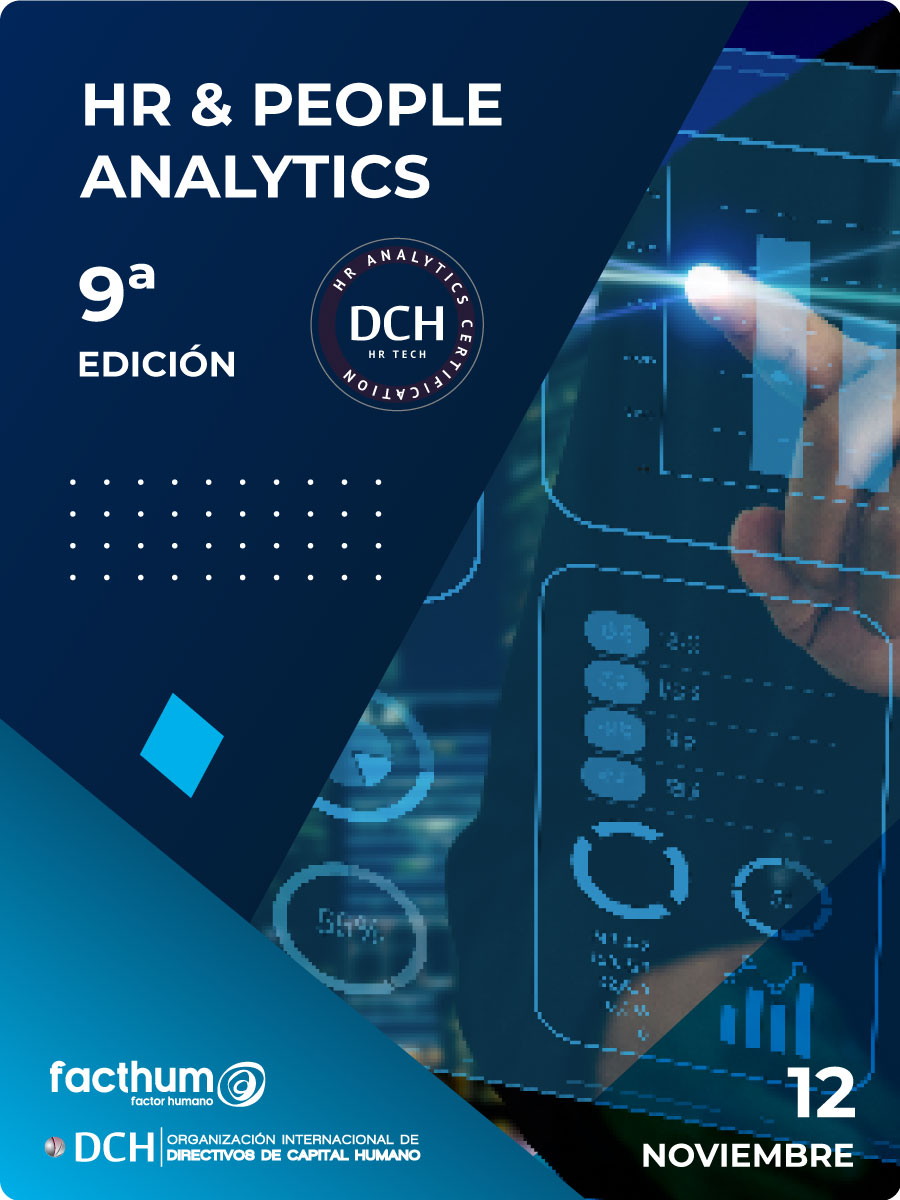
HR & People Analytics Program
DESCRIPTION
71% of companies consider HR Analytics a high priority for their business.
Digital transformation is profoundly changing the future of work and human resource management. Technology gives us, in addition to others, the advantage of having more data or information and it is of vital importance that we know how to analyze them to be able to improve processes since: “Everything that is measured, improves” and the data of RR. HR are the most important assets that any company has at its disposal. But companies are not as advanced when it comes to getting to know their employees.
- Do you know the business impact of losing talent?
- The cost of recruitment and the lengthy adaptation process for new employees?
- Who is the best internal or external candidate for a vacancy?
- How much return on investment is the capital resource giving us?
“Everything that gets measured, gets better,” and the PR data is a good example of this. HR are the most important assets that any company has at its disposal.
OBJECTIVES
- This course will equip you with the practical knowledge and skills to apply HR Analytics in your organization.
- Understand what HR Analytics is and how we can apply it to a company.
- Understand the need to move the HR function from operational to strategic.
- Learn how to develop a culture focused on HR Analytics.
AIMED AT
PR Managers HR, HR Professionals HR Analysts, HR Analysts HR, HRBP, Managers and Leaders in general.
Edition: 9th
Duration: 15 hours
Session 1: Tuesday, November 12 from 3:30 p.m. to 6:30 p.m. Session 2: Thursday, November 14, from 3:30 to 6:30 p.m. Session 3: Tuesday, November 19 from 3:30 p.m. to 6:30 p.m. Session 4: Thursday, November 21 from 3:30 p.m. to 6:30 p.m. Session 5: Tuesday, November 26 from 3:30 p.m. to 6:30 p.m. Schedule: 15:30h to 18:30h (Spain)
Faculty
Program contents
1
REDEFINING RR. HH.
THE CONTEXT OF CHANGE
The world is full of data and information that is impacting our lives. They predict everything from what we would like to buy based on our shopping tastes, to how our bodies and well-being are doing through the many technological applications available to us.
For some time now, the PR function has been a key function of the company’s PR department. HR is grappling with complex business challenges, as well as the introduction of new technologies, making it an increasingly data-driven and evidence-based profession.
But it all starts with a change of mentality to want and know how to work with data, since words without numbers are just opinions.
-
CONTENTS
RR. HH. and the new world of work.
- Employee experience automation.
- The 3 Ds: Data, Digital and Design.
Shifting HR into a people-focused function.
- “Selling” the people function to senior management.
Measuring business value, key success factors.
- The people function as a profit center.
HR Analytics and People Analytics.
- What is HR & People Analytics?
- Fundamentals and benefits of HR & People Analytics.
Case study: measuring the value of people.
- HR Professional Experience. Guest Speaker.
- Guest entity
2
CHANGING RR. HH.
TOWARDS A DATA-DRIVEN APPROACH
We know that on average 60-80% of the company’s average costs depend on people and yet many HR functions are still dependent on people. HR do not understand the business or are not able to describe the commercial return on those expenditures. It is necessary for the PR function to be able to provide a clear and effective response to the needs of the company’s customers. HR develops a commercial and business capability to align HR policies with the company’s strategic plan from a data-driven and evidence-based approach. PR professionals are not only a part of the PR team, they are also a part of the PR team. HH. must move from “I believe” to “I prove”.
CONTENTS
Data and HR & People Analytics in HR.
- Types of analytics
- Main management indicators used by the Human Resources management. HH.
The commercial mindset in HR.
- Business Competencies in HR: The 6 Cs
- Commercial Orientation Self-Assessment
Working with data
- From data to information to knowledge
- Creating business cases with data and technology
Case Study: Business case of ROI for a personnel development program.
-
- HR Professional Experience. Guest Speaker.
3
HR ANALYTICS AND EVIDENCE-BASED DECISION MAKING
In order to make decisions effectively, we must first solve the main problems or questions based on a proper diagnosis, otherwise we would be led to make a bad solution.
The main value of HR Analytics is to help us make evidence-based decisions, as long as we ask the right questions to help us identify what the real issues are. Therefore, it is not only important that we know the processes and tools necessary for the application of HR Analytics, but also the development of an HR Analytics organizational culture to sustain our actions.
CONTENTS
HR & People Analytics framework.
- A process for moving from reporting to analytics. How data leads to different conversations.
- What key questions drive the analyses.
Development of a data culture.
- Importance of implementing a data culture.
- Culture and leadership based on analytics.
Case study: Growing sales through HR & People Analytics.
- HR Professional Experience. Guest speaker
4
HR ANALYTICS IN PRACTICE
All knowledge must be put into practice through an action plan from HR focused on HR Analytics, which also has to be realistic in order to be implemented. To this end, it is key that the HR function develops and enhances both technical and functional HR Analytics capabilities within the organization.
There is a wide variety of human resource management systems and processes aimed at maximizing the return on investment in personnel within our company, but when we have to evaluate how our competitors do it, accurate assessment and international relevance becomes difficult. The new ISO 30414 standard provides us with globally agreed forms for internal and external human capital reporting, to get a clear view of the real contribution of human capital to long-term success.
CONTENTS
How to be a data-driven function focused on HR Analytics.
- How to Develop Data-Driven Capabilities Defining an HR Analytics Strategy
- What is and how to implement a Balanced Scorecard (BSC) Data analysis in HR & People Analytics
- The importance and quality of data
Introduction to International HR Metrics Standards (ISO 30414)
- What are international HR standards?
- Benefits and target groups
The main areas and metrics
Case Study: Solving Business Problems through HR Analytics
-
-
- HR Professional Experience.
-

